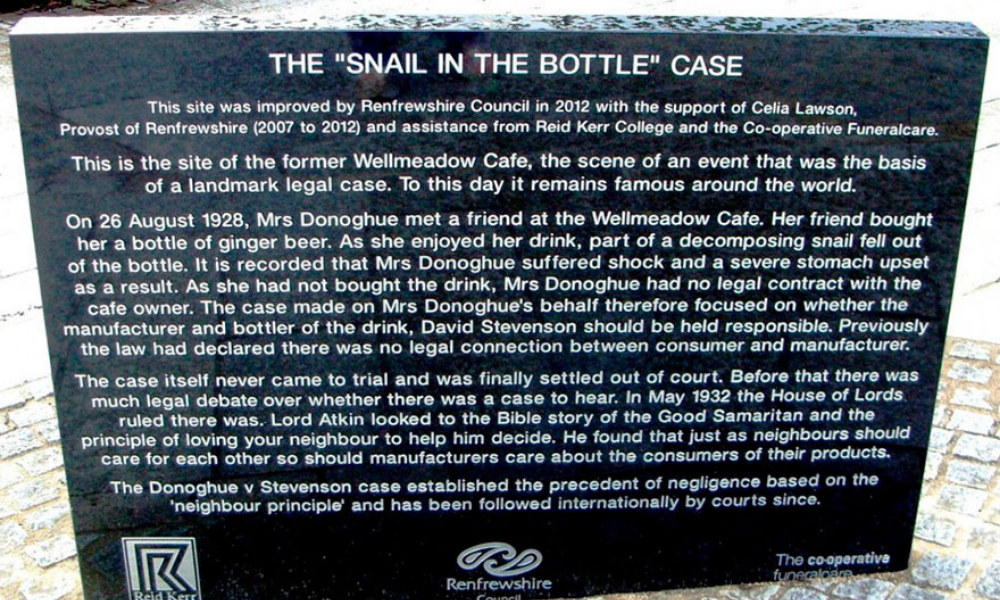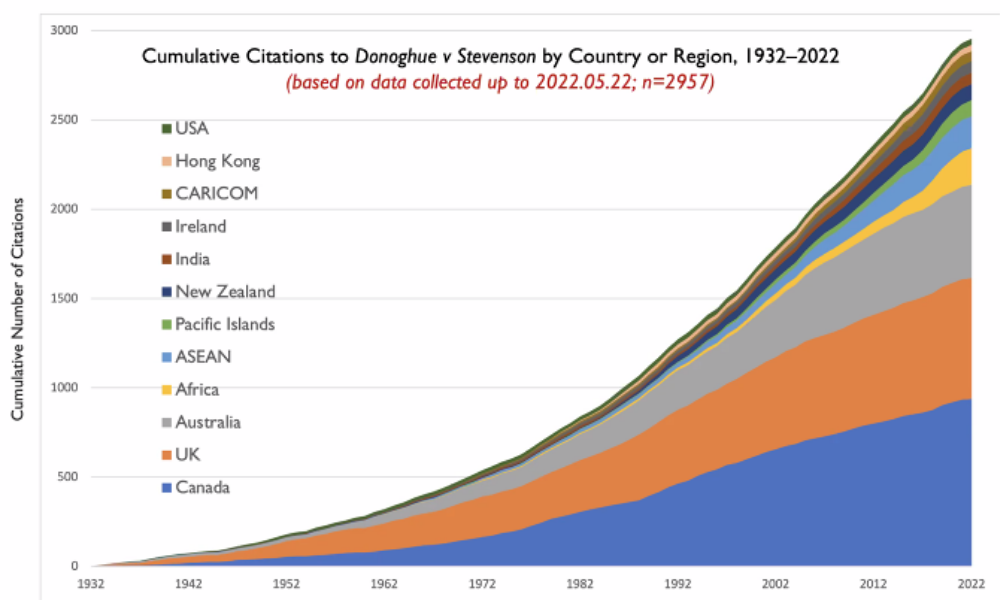Canadians featured in global conference on famed litigation that modernized negligence in Common Law

Every law student in common law countries, including Canada, has had to learn about what has become known as the “Paisley snail” case – Donoghue v. Stevenson
It details the travails of a woman of modest means who brought an action against the maker of a ginger beer served to her while with a friend at a cafe in Paisley, Scotland, in 1928. The bottle of ginger beer is said to have contained the decomposed remains of a snail, which she said made her physically sick and emotionally horrified.
The case represents one of the common law’s most famous turning points, defining the modern concept of negligence by establishing circumstances where one party owes a duty of care to another party even if there are intervening third parties involved.
And while the lessons and precedents from that case may seem old hat today, it still reverberates 90 years after the famous decision that came down on May 26, 1932. Indeed, legal practitioners and scholars worldwide gathered in a worldwide “virtual” celebration this past Thursday (May 26) to pay homage to the decision's anniversary and acknowledge the importance and the implications it still has on legal principles today. Such is the strong mythology surrounding the case that the conference was entitled “The Immortal Snail.”
Hosted by the Law Society of Scotland, the conference featured 40 speakers, spanning five continents and 14 countries, including New Zealand, Australia, Hong Kong, Singapore, and Nigeria. There was a strong Canadian contingent among the speakers, comprised of Justice Russell Brown of the Supreme Court of Canada, Professor John Kleefeld of the University of New Brunswick, and retired BC judge Martin Taylor.
Though cited thousands of times worldwide in negligence cases since it came down, the case still invites debate today. Justice Brown told conference attendees: “Ninety years after Donoghue v. Stevenson, the duty of care formulation, or more particularly the terms that state the circumstances creating the duty of care, still attract controversy in Canada.”
For those who have forgotten the details, the Donoghue case revolves around May Donoghue consuming a ginger beer and ice cream float purchased by her friend. When she poured the remainder of her ginger beer from an opaque bottle, she said a decomposed snail emerged, making her ill. She then commenced a personal injury claim against the beer manufacturer, Stevenson.
Because she did not purchase the beer herself, Donoghue did not have a contract with the cafe proprietor or the manufacturer. However, when the case eventually went to the UK House of Lords, it ruled in her favour by a narrow 3-2 decision.
The House of Lords’ decision stated that the beer manufacturer owed a duty of care to Donoghue because she was the consumer of the ginger beer, and it was irrelevant that she had not bought the bottle. Writing the decision for the majority, Lord James Richard Atkin stated:
“The rule that you are to love your neighbour becomes in law you must not injure your neighbour; and the lawyer’s question ‘Who is my neighbour?’ receives a restricted reply. You must take reasonable care to avoid acts or omissions, which you can reasonably foresee would be likely to injure your neighbour.”
Lord Atkin added: “Who then in law is my neighbour? The answer seems to be persons who are so closely and directly affected by my act that I ought reasonably to have them in contemplation as being so affected when I am directing my mind to the acts or omissions which are called in question.”
In addition to developing this “neighbour” principle of common law, the decision has several other several, such as
- negligence is distinct and separate in tort;
- there does not need to be a contractual relationship for a duty to be established, and
- manufacturers owe a duty to the consumers who use their products.
Justice Brown told attendees during his address that two issues, in particular, continue to challenge the SCC.
The first is the breakdown of an integrated conception of duty. Justice Brown pointed to a 2001 SCC judgment, Cooper v. Hobart, that reconfigured the duty analysis around categories of recognized duties of care, typically according to the harm caused by a breach or foreseeable physical harm or the negligent act itself such as negligent misstatement.
The Cooper case “reformulated the Canadian duty of care analysis from its prior rigid adherence to the Anns test [Anns v Merton London Borough Council], which grounded a prima facie relationship of duty upon whether, in the reasonable contemplation of the defendant’s carelessness . . . it may cause damage to the plaintiff.”
Justice Brown said there is now a formulation that breaks the prima facie duty inquiry down into two separate questions – reasonable foreseeability of harm and proximity of relations between the defendant and plaintiff. He said that mere foreseeability is not enough to recognize a new duty of care. The plaintiff must show proximity – that the defendant was in a close and direct relationship in the circumstances. The factors which may satisfy the requirement of proximity are diverse and depend on the facts of the case.
The second difficulty for the Supreme Court of Canada, Justice Brown said, has been its preoccupation with avoiding indeterminate liability. “The concern, which arises most often but not exclusively in cases of pure economic loss, is that a single act of negligence might have limitless ramifications.”
Justice Brown added that “for several decades Canadian Common Law judges came to allow indeterminate liability to become the policy consideration tail that wags the duty of care dog, but if we take Donoghue v. Stevenson seriously, indeterminate liability really shouldn’t have much to do with the duty of care at all.”
The SCC judge concluded by saying, “my point is that, as the Supreme Court of Canada’s peripatetic jurisprudence on this very point demonstrates, we do well to avoid distractions like indeterminate liability and focus instead on taking the neighbour principle seriously.”
In his presentation, the University of New Brunswick’s Kleefeld discussed the global influence of the case and where the impact of Donoghue has been most keenly felt. He pulled together citation data worldwide and organized it for qualitative and quantitative analysis.

Memorial stone at site of Wellmeadow Cafe
Kleefeld has collected close to 3,000 separate citations, showing a steadily increasing use trendline since the decision came out in 1932. One method of organizing the data shows the cumulative citations of Donoghue organized by country.
Isolating the citations this way shows Canada with just short of 1,000 cumulative references. However, Kleefeld pointed out that he is based in Canada and has access to numerous databases that have done a “fantastic job of going back in time” for this research.
The conference ended with BC’s Taylor paying homage to other events that celebrated the Donoghue case, including the 1990 “Pilgrimage to Paisley” conference co-sponsored by the Canadian Bar Association, the Faculty of Advocates, and the Law Society of Scotland.
Taylor said that event culminated with a march behind a bagpipe band by 250 Canadian judges, lawyers and academics to the site of the Wellmeadow cafe, where May Donoghue was served the infamous ginger beer and ice cream float.
Other events and tributes celebrating the decision and its impact include:
- The 1982 50th anniversary of the “great Paisley snail case” was celebrated with what was billed as “The World’s First-Ever Donoghue v. Stevenson Festival.” The centrepiece was a debate between two leading Canadian torts scholars entitled “The Good Neighbour on Trial” and subtitled with the question: “Has Too Much Been Done for the Sufferer?” Justice Allen Linden, then of the Ontario Supreme Court, proclaimed Lord Atkin’s judgment “the seed of an oak tree, a beacon of hope, a fountain of sparkling wisdom, a skyrocket bursting in the midnight sky.” University of British Columbia law professor Joe Smith delivered a more skeptical view. He said: “Our rights of freedom of action are in danger of being eroded by judges who see themselves as guardian of public morality and view the restructuring of society to force us all to become Good Samaritans as a proper judicial function.”
- A 1983 dinner in Vancouver honouring John Leechman, son of Scottish solicitor Walter Leechman, who took on May Donoghue’s case. Leechman’s said that his father was a meticulous solicitor. He would not have taken the case without having interviewed May Donoghue and her friend closely and would have satisfied himself they were telling the truth. Leechman told the dinner audience that his father settled her claim with Stevenson’s executors for 200 pounds.
- A book, Donoghue v. Stevenson and the Modern Law of Negligence: The Paisley Papers, an illustrated account of the 1990 proceedings published in 1991 by the Continuing Legal Education Society of BC.
- A documentary, The Paisley Snail, was produced by BC Queen’s Counsel David Hay and made its debut at the 1996 Commonwealth Law Conference in Vancouver.
Yet to come, said Taylor, who served as both a BC superior court and court of appeal judge, is a musical now in the works — May and the Paisley Snail – with lyrics by Vancouver counsel and author Bruce Fraser.

Source: John Kleefeld
“Its premiere performance has had to be adjourned sine die by the pandemic,” Taylor said.
“The facts and history of the case, its people and places are as important to its fame as the vast jurisprudence that it has spawned,” Taylor told attendees, noting a group of Donoghue case enthusiasts called the Paisley Irregulars, who meet annually.
“There are people here in Vancouver who for 40 years now have been thinking of little else.”
Note: Conference attendees were told by one of the Law Society of Scotland hosts that the case should be called “Donoghue against Stevenson,” according to Scottish legal practice, though most attendees continued to use ‘v,’ ‘versus’ or ‘Donoghue and Stevenson.’”










